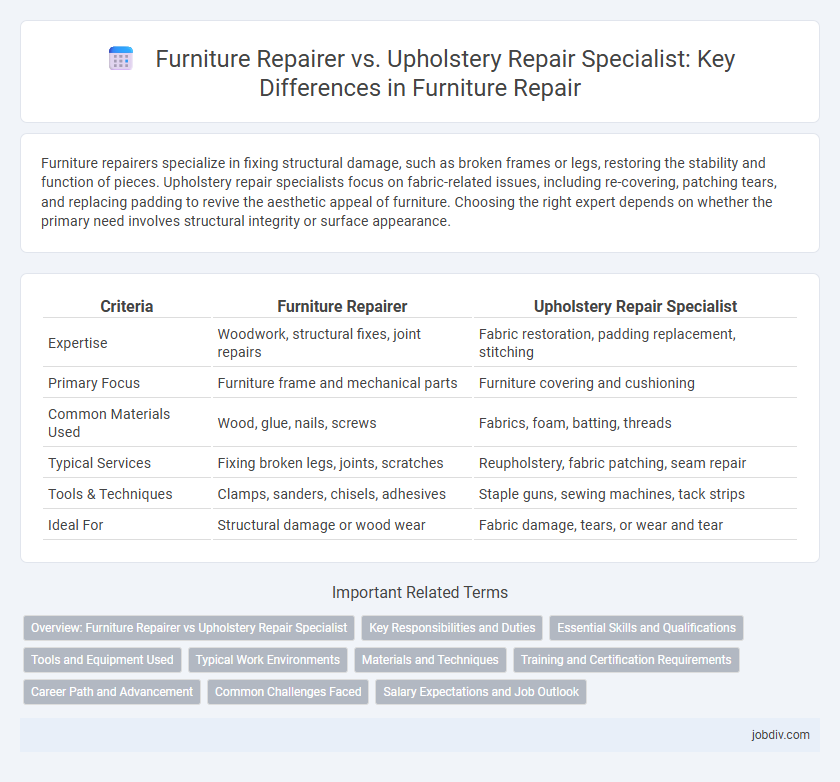Furniture repairers specialize in fixing structural damage, such as broken frames or legs, restoring the stability and function of pieces. Upholstery repair specialists focus on fabric-related issues, including re-covering, patching tears, and replacing padding to revive the aesthetic appeal of furniture. Choosing the right expert depends on whether the primary need involves structural integrity or surface appearance.
Table of Comparison
| Criteria | Furniture Repairer | Upholstery Repair Specialist |
|---|---|---|
| Expertise | Woodwork, structural fixes, joint repairs | Fabric restoration, padding replacement, stitching |
| Primary Focus | Furniture frame and mechanical parts | Furniture covering and cushioning |
| Common Materials Used | Wood, glue, nails, screws | Fabrics, foam, batting, threads |
| Typical Services | Fixing broken legs, joints, scratches | Reupholstery, fabric patching, seam repair |
| Tools & Techniques | Clamps, sanders, chisels, adhesives | Staple guns, sewing machines, tack strips |
| Ideal For | Structural damage or wood wear | Fabric damage, tears, or wear and tear |
Overview: Furniture Repairer vs Upholstery Repair Specialist
Furniture repairers specialize in restoring the structural integrity and functionality of various furniture pieces, addressing issues such as broken frames, loose joints, and surface damage. Upholstery repair specialists focus specifically on the fabric and padding of furniture, repairing or replacing cushions, springs, and covering materials to restore comfort and appearance. Both professions require distinct skills and tools tailored to either the wood or fabric components of furniture restoration.
Key Responsibilities and Duties
Furniture repairers specialize in restoring the structural integrity of wooden and metal furniture by fixing broken legs, joints, and frames using techniques like sanding and refinishing. Upholstery repair specialists focus on the restoration and replacement of fabric, leather, padding, and springs to enhance the comfort and appearance of furniture. Both roles require precise craftsmanship, but upholstery repair demands expertise in selecting materials and sewing, while furniture repair emphasizes carpentry skills and surface restoration.
Essential Skills and Qualifications
Furniture repairers require proficiency in woodworking, finishing techniques, and basic structural repairs to restore furniture integrity and aesthetics, often holding certifications in carpentry or furniture restoration. Upholstery repair specialists need advanced skills in fabric selection, sewing, padding replacement, and knowledge of textile properties, typically backed by formal training in upholstery or textile repair. Both roles demand attention to detail, manual dexterity, and a strong understanding of materials to ensure high-quality restorative outcomes.
Tools and Equipment Used
Furniture repairers primarily use hand tools such as chisels, hammers, screwdrivers, and sanders to restore wooden structures and fix joints. Upholstery repair specialists rely on specialized equipment including staple guns, sewing machines, tack removers, and foam cutters to replace fabric, padding, and springs. Both trades require precision tools, but upholstery repair demands more textile-focused instruments for fabric manipulation and cushioning replacement.
Typical Work Environments
Furniture repairers typically work in workshops, home service settings, or furniture manufacturing facilities, handling wooden, metal, or composite materials to restore structural integrity and appearance. Upholstery repair specialists operate mainly in upholstery shops, furniture stores, or home environments, focusing on fabric, leather, foam, and cushioning restoration to improve comfort and aesthetics. Both professions require well-equipped spaces with access to specialized tools, but upholstery specialists emphasize textile handling, whereas furniture repairers prioritize carpentry and material refinishing.
Materials and Techniques
Furniture repairers excel in restoring wood, metal, and composite frames using techniques like sanding, refinishing, and structural reinforcement, ensuring durability and aesthetic quality. Upholstery repair specialists focus on fabrics, leathers, and padding, employing methods such as re-stitching, foam replacement, and fabric reupholstering to maintain comfort and appearance. Mastery of specific materials and specialized tools differentiates each role, with furniture repair addressing structural integrity and upholstery repair enhancing surface aesthetics and comfort.
Training and Certification Requirements
Furniture repairers typically require hands-on experience and vocational training focused on carpentry and materials restoration, often supplemented by certifications from trade schools or industry organizations. Upholstery repair specialists undergo specialized training in fabric handling, padding, and sewing techniques, frequently earning credentials from upholstery-specific certification programs. Both professions demand continuous skill development to stay updated with modern materials and repair technologies.
Career Path and Advancement
Furniture repairers primarily focus on restoring wooden and structural elements of furniture, developing skills in woodworking, sanding, and refinishing, which often leads to roles in custom furniture making or antique restoration. Upholstery repair specialists gain expertise in fabric replacement, cushion repair, and frame adjustments, positioning themselves for advancement in interior design firms or specialized upholstery businesses. Both career paths offer opportunities for certification and entrepreneurship, with upholstery specialists generally benefiting from growing demand in residential and commercial markets.
Common Challenges Faced
Furniture repairers and upholstery repair specialists both encounter challenges such as restoring structural integrity while preserving aesthetic appeal. Common issues include identifying suitable materials that match original textures and colors, as well as addressing wear and tear without compromising comfort or durability. Mastery of diverse tools and techniques is essential to overcome problems like fabric deterioration, wood damage, and intricate design restoration.
Salary Expectations and Job Outlook
Furniture repairers typically earn a median annual salary of around $35,000 to $45,000, while upholstery repair specialists can expect salaries ranging from $30,000 to $50,000 depending on skills and experience. Job outlook for furniture repairers is steady with moderate demand driven by consumer interest in restoration and sustainable practices, whereas upholstery repair specialists may see faster growth due to niche expertise in fabric and cushioning restoration. Employment opportunities in both fields often depend on regional market trends and consumer preferences for custom or eco-friendly furniture maintenance.
Furniture Repairer vs Upholstery Repair Specialist Infographic

 jobdiv.com
jobdiv.com